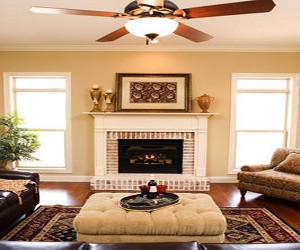 Ceiling fans are not a necessity, but can be useful in circulating air throughout a room. While a ceiling fan will not actually reduce the temperature, in summer, circulated air can make a room feel five to seven degrees cooler. In winter, a ceiling fan will force warm air downwards and make a room feel warmer.
Ceiling fans are not a necessity, but can be useful in circulating air throughout a room. While a ceiling fan will not actually reduce the temperature, in summer, circulated air can make a room feel five to seven degrees cooler. In winter, a ceiling fan will force warm air downwards and make a room feel warmer.
To achieve the desired result, the fan should be pulling air toward the ceiling in the summer and reversed so it pushes air to the floor in the winter. In this way, fans can help with energy savings because rooms feel more comfortable. Although, keep in mind these savings vanish when fans are left running when no one is occupying the room.
Ceiling fans can be installed by do-it-yourselfers, but instructions must be followed carefully to make sure the fan is secure and runs correctly. An indoor ceiling fan is not designed for exterior use and can be unsafe if installed outdoors or in a humid environment, such as a covered porch or a bathroom. Fans that are rated “damp” are safe for humid environments, but should never be used where they might come into direct contact with liquid. Only fans with a “wet” rating are safe for contact with liquid, as they are equipped with sealed motors, rust-resistant housing and stainless steel hardware.
Ceiling fans are heavier than most light fixtures and it can take two people to lift and attach the fan to the junction box. In all cases, the junction box must be rated to hold the fan, or the fan can actually fall down, causing an extreme safety hazard.
In fact, a fan detaching from the ceiling is much more dangerous than contact with moving blades. Ceiling fans will strike and injure an out-stretched hand, but a falling fan can seriously injure anyone unlucky enough to be underneath it.
Just because a junction box can support a fan doesn’t mean it is rated to do so. During operation, a fan exerts additional force that can cause the box to fail and the fixture to fall. A light fixture should never be replaced with a ceiling fan without upgrading the junction box.
Wobbling of ceiling fans is another common issue that can occur if fan blades are out of balance, misaligned, warped, bent or not screwed in tightly enough. While a wobbling fan is not dangerous in and of itself, wobbling can cause light fixtures covers to shades to loosen and possibly fall.
In terms of height, no part of a ceiling fan blade should be closer than seven feet to the floor. Low-profile fans are available for ceilings that are lower than 8 feet from the floor. All fan blades should be at least 18 inches away from walls.




